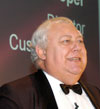Want to improve your customer relationship? Start first by looking at how you improve the internal customer relationships. Paul Cooper investigates.
It is difficult to overstress the importance of the role of employees in an organisation to achieve and maintain high standards of customer service excellence. But still there remains, in many organisations, a stronger commitment to the external customer than there is to the “internal customer”. However, getting it right internally first is the secret of real, long-lasting success.
So let’s look first at the people issue, and then move on to cover the internal customer relationship.
The employee journey
A good organisation has expectations of its staff, but fundamentally these break down to a hope that the right people will:
- Join
- Attend
- Perform
- Stay
The problem, however, is often that these remain exactly that – hopes. There is often little or no active planning to ensure that it happens consistently.
Join – Good organisations are always working towards improving their reputation in the market as a great employer, stimulating a strong desire for people to aspire to work there.
Attend – Organisations with high employee motivation and satisfaction have much lower levels of absenteeism and lower turnover; high levels of teamwork are in place and bosses are leaders/coaches, not dictators.
Perform – Good organisations train their people, consistently, not reducing this if times turn difficult; they use the right measuring tools, not measure what is easy, and they give regular positive feedback.
Stay – Too many organisations have unacceptable levels of headcount turnover, and yet are surprised whenever someone leaves. How many times do they (metaphorically) put their arms round their employees and tell them how important they are, and that they wouldn’t want them to leave?
But getting these things right is just the start of the process. The key is to take these “efficiency” factors and develop them into “effectiveness” factors.
The more areas in an organisation where work is handed over or moved around, the more chances there are of something going wrong. At these “handover” points, paperwork can be held up, or produced wrongly; goods can be packaged wrongly, or lost; calls can go unanswered, messages not passed on, etc.
Attitude
In most cases the solution to all of this is attitude. Of course, processes and technology can help to reduce error, but, in the end, it stems from everyone seeing everyone else as a customer, and therefore delivering high service levels BOTH WAYS in the chain.
There should be no hierarchies in serving the customer

Paul Cooper
To do this, a key element is respect. Everyone in the chain is equal, and crucial to success. The role of both the supervisor and manager is to ensure that the steps in the process are minimised, and that everything is running smoothly – “oiling the wheels”. Their contributions include resourcing, communicating, coaching and developing – i.e. “making it work”.
Let’s face it, in most organisations today this isn’t easy. However, it is certainly made easier by being aware of all of the above points with regard to employees, and their development and welfare. With real professionals on the team, the job is half done already.
Paul A Cooper is a Director of Customer Plus
Paul won the Lifetime Achievement award at the European Call Centre Awards 2011.
Author: Jo Robinson
Published On: 8th Feb 2012 - Last modified: 26th May 2017
Read more about - Customer Service Strategy, Motivation, Staff Recognition, Staffing















